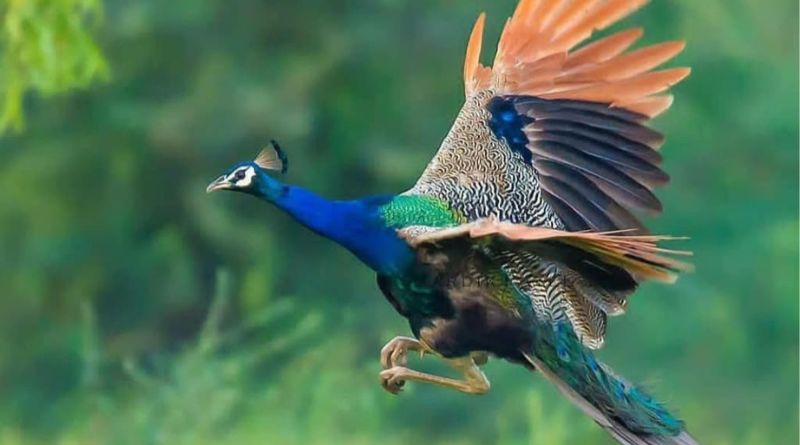Peacocks are known for their stunning beauty, particularly their vibrant plumage and elaborate tail feathers. Often associated with grace and elegance, these birds evoke a sense of wonder and curiosity. One common question that arises is: do peacocks fly? This article explores the anatomy, behavior, and flying capabilities of peacocks, shedding light on their unique characteristics and lifestyles.
Table of Contents
Understanding Peacocks
The Species
Peacocks are the male members of the peafowl species, which belong to the genus Pavo. The most well-known species is the Indian peafowl (Pavo cristatus), native to the Indian subcontinent. The females are called peahens, and together they exhibit a fascinating range of behaviors and traits.
Physical Characteristics
Peacocks are renowned for their spectacular tail feathers, known as the “train.” These feathers can grow up to six feet long and are adorned with eye-catching patterns that shimmer in the sunlight. The vibrant colors and intricate designs serve as a means of attracting mates, particularly during the breeding season.
In addition to their impressive tails, peacocks have robust bodies, long legs, and a distinctive crest of feathers on their heads. Their plumage is not only beautiful but also serves various purposes, including camouflage and social signaling.
Do Peacocks Fly?
Flight Capabilities
Peacocks are indeed capable of flight, though they are not the most proficient fliers among bird species. Here are some key points regarding their flying abilities:
- Short Distances: Peacocks can fly short distances, typically up to 10 to 15 feet high. They are more adept at short bursts of flight than sustained, long-distance flying.
- Takeoff: To take off, a peacock will often run and flap its wings vigorously. Once airborne, they can glide briefly before landing. This flying style is more about evading predators or reaching higher ground, such as tree branches.
- Roosting Behavior: Peacocks frequently fly into trees to roost at night, providing safety from ground predators. Their ability to perch high helps them avoid danger and gives them a vantage point to observe their surroundings.
Limitations to Flight
Despite their ability to fly, several factors limit their flying prowess:
- Weight and Size: The long and heavy train of feathers can hinder their ability to achieve sustained flight. The train adds significant weight and drag, making it challenging for peacocks to gain altitude quickly.
- Wing Structure: While peacocks have strong wings, their body shape and size affect their flight capabilities. They are not built for long-distance travel like some other birds, such as hawks or swans.
Behavior and Habitat
Social Structure
Peacocks are social birds that often form small groups known as “herds” or “parties.” These groups typically consist of a dominant male, several females, and their offspring. Males display their impressive tail feathers during courtship rituals to attract females, a behavior known as “train display.”
Habitat Preferences
Peacocks prefer habitats that offer a mix of open ground and tall trees. They are commonly found in forests, grasslands, and agricultural areas. Their adaptability to various environments has allowed them to thrive in both wild and domestic settings.
Conservation Status
While peafowl populations are generally stable, they face threats from habitat loss and hunting in certain regions. Efforts to conserve their natural habitats and protect them from poaching are essential for their survival. In many places, they are kept as ornamental birds in parks and estates, which raises awareness about their conservation.
Frequently Asked Questions
1. Can peacocks fly high?
Peacocks can fly to heights of about 10 to 15 feet, primarily for short distances. They are not long-distance fliers and typically fly to escape predators or reach a perch.
2. Why do peacocks have such long tail feathers?
The long tail feathers of male peacocks serve as a mating display. During courtship, males fan out their trains to attract females, showcasing their health and vitality.
3. Are peacocks aggressive?
Peacocks can be territorial, especially during mating season. They may display aggressive behavior to establish dominance or protect their territory, but they are generally not dangerous to humans.
4. How long do peacocks live?
In the wild, peacocks typically live around 15 to 20 years. In captivity, with proper care, they can live even longer, sometimes reaching up to 25 years.
5. Do peacocks mate for life?
Peacocks do not mate for life. Instead, they engage in seasonal breeding, where males display to attract multiple females. Females choose mates based on the quality of their displays.
6. Can peacocks be kept as pets?
Peacocks can be kept as pets, but they require ample space and a safe environment. They thrive in large outdoor areas where they can roam and perch. Keep in mind that they can be noisy, especially during mating season.
7. What do peacocks eat?
Peacocks are omnivorous and have a varied diet that includes grains, seeds, fruits, insects, and small reptiles. In captivity, they are often fed commercial poultry feed supplemented with fresh fruits and vegetables.
8. Are peacocks related to chickens?
While peacocks and chickens are both birds, they belong to different families. Peacocks are part of the pheasant family (Phasianidae), while chickens belong to a different genus within the same family.
Conclusion
In conclusion, peacocks can indeed fly, but their flying abilities are limited to short distances. Their stunning plumage and intricate behaviors make them one of nature’s most captivating birds. Understanding the capabilities and limitations of peacock flight enhances our appreciation for these remarkable creatures and their place in the ecosystem. Whether admired for their beauty or their unique behaviors, peacocks continue to fascinate and inspire people around the world.



